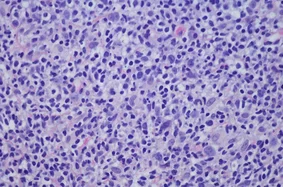


Clinical Research
Stage I Nodal Marginal Zone Lymphoma Treatment Landscape
Stage I Nodal Marginal Zone Lymphoma Treatment Landscape
Houston Methodist researchers compared systemic therapy and radiation therapy in Stage I Nodal Marginal Zone Lymphoma Patients
Houston Methodist researchers compared systemic therapy and radiation therapy in Stage I Nodal Marginal Zone Lymphoma Patients
Lymphomas are characterized by presence of cancerous cells in the lymph nodes and organs. Various types of lymphomas exist. Marginal zone lymphomas (MZL) are a group of rare, slow-growing non-Hodgkin lymphomas that usually affect men older than 60.
One specific subtype of MZL is nodal MZL (a rare mature B-cell neoplasm) that accounts for 10% of all MZLs and 1-2 % of all lymphomas. NMZL is indolent in more than 90% of patients, the median age of diagnosis is 66-69 and is limited to lymph nodes.


Bin S. Teh, MD, FACR, FASTRO, FACRO
Bin S. Teh, MD, FACR, FASTRO, FACRO, Jim and Joan Harrell Centennial Chair in Radiation Oncology, and Professor of Radiation Oncology published a study in Practical Radiation Oncology, which compared the prognostic effects of systemic therapy (ST) and radiation therapy (RT) in stage I NMZL, and found that RT improved overall survival (OS) relative to no RT and that ST was not a factor associated with OS.
Stage I NMZL is extremely rare and localized to a single lymphatic region. Due to this rarity, its treatment landscape is based on limited evidence. Current guidelines allow observation or treatment with RT, ST, or both. Typically, ST entails CD20-directed therapy with or without chemotherapy. However, the official preferred treatment is RT alone.

This is largest study to date investigating the impact of systemic therapy and radiation therapy in stage I Nodal Marginal Zone Lymphoma. In the overall cohort, the present results demonstrate an overall survival benefit with radiation therapy compared with no radiation therapy, and systemic therapy was not a prognostic factor.

Bin S. Teh, MD, FACR, FASTRO, FACRO
Jim and Joan Harrell Centennial Chair in Radiation Oncology, and Professor of Radiation Oncology at Houston Methodist
Teh and his team leveraged data points from the National Cancer Database (NCDB) to perform a retrospective study to evaluate the prognostic effect of ST and RT in Stage I NZML.
The NCDB, which sources hospital registry data from more than 1,500 Commission on Cancer-accredited facilities, was queried from 2004 and 2018 for all NMZL patients with a histologically confirmed diagnosis who did not undergo lymph node excision. Out of 3,201 patients who met the inclusion criteria, 3,137 survived at least one month, 57% were female and 88% were white. Categories based on tumor site included neck, intrathoracic, intra-abdominal, axilla, inguinal, pelvic and the remainder were unspecified.
“This is largest study to date investigating the impact of ST and RT in stage I Nodal Marginal Zone Lymphoma,” said Teh. “In the overall cohort, the present results demonstrate an overall survival benefit with radiation therapy compared with no radiation therapy and systemic therapy was not a prognostic factor. Because the median patient age was 67, as expected the overall survival benefit with radiation therapy tapers off around 12 to 15 years after diagnosis as patients die of other causes.”
The total cohort of 3,201 patients were stratified into four treatment groups:
49%
Observation
23%
ST
25%
RT
25%; with three
sub-categories
of dosages
4%
Both ST and RT
Rigorous statistical analyses revealed:
- Female gender was a prognostic factor for OS.
- RT was underutilized since only 29% of patients received RT.
- There was a positive prognostic effect of RT for the tumor sites of the neck and axilla.
Teh and his colleagues noted that RT was poorly utilized, which could be due to concerns about RT-related toxicity. Additionally, RT might have been avoided in cases of tumors in certain locations such as intra-abdominal. The authors emphasize the importance of consulting a radiation oncologist to determine the feasibility of RT, regardless of tumor site location. Future studies are likely to shed additional light on the optimal treatment strategies for Stage I NMZL.
“This study provides evidence for the role of radiation therapy in stage I nodal zone marginal lymphoma. At a bare minimum, a radiation oncologist should be consulted for all patients with stage I nodal marginal zone lymphoma for multidisciplinary decision-making and to discuss the feasibility of radiation therapy,” added Teh.
Neil Chevli, Victoria Margolis, Waqar Haque, Sai Ravi Pingali, E Brian Butler, Bin S The. Prognostic Effect of Systemic Therapy and Radiation Therapy in Stage I Nodal Marginal Zone Lymphoma. Pract Radiat Oncol. 2023 Jan-Feb;13(1):e80-e93. doi: 10.1016/j.prro.2022.10.001.
Share this story
Abanti Chattopadhyay, PhD
December 2024
Related Articles






